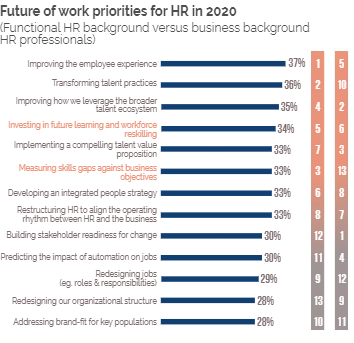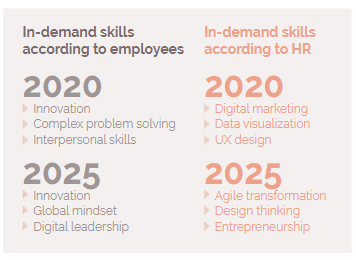The race to reskill post-COVID-19

If reskilling is one of the biggest opportunities for business to ready their workforce for the future, it is also one of the biggest challenges. Without accelerating our progress on the skills agenda, we won’t have the talent to take advantage of the new jobs we are creating. This is both a business and an HR challenge, and it, therefore, demands organization-wide interventions to deliver results. Companies that unlock reskilling at speed and scale will transform at a pace that leave their competitors behind.
Google Health announced that its AI system was just as good, if not better than human radiologists at detecting breast cancer. The implications for radiologists—for example, around selection requirements and on-the-job clinical training—and for those in downstream jobs, such as radiology technicians, are uncertain. This is just the first trickle of such watershed moments to come. Meanwhile, an event like COVID-19 gives us the impetus to think about how the workforce can be reskilled from one sector to another.
Mercer’s 2020 Global Talent Trends Study reveals that current realities and unresolved debates weigh us down, even as we see a future full of opportunities in this new decade. An opportunity which, for now, seems halted by COVID-19. The changes we are witnessing, brought about by uncertain times, are not only disrupting our present but will set a new normal in how we live, work, operate, and do business.
78% of employees say they are ready to reskill. The question is not who can adapt, but how best to develop an adaptable workforce, finds the study
Rushing to reskill
The report highlights that skills have been high on the business agenda since technology’s impact on jobs became apparent. This year, executives state an urgent and clear mandate for reskilling to drive transformation. Globally, reskilling is seen as the top talent activity most capable of delivering a Return on Investment (RoI) in the eyes of executives. And this RoI assumption makes sense, given that 99% of all companies are both embarking on a transformation this year and reporting significant skill gaps. Combined with executives’ increasing apprehension around talent migration this year (up from 4% in 2017 to 38% in 2020), skill supply concerns are high on the priority list.
As agility has become the mantra of transformation, reskilling is the practical lens through which to measure progress. When asked what is most important to “being more agile”, only 5% of companies said agile work practices (such as iterative product build and prototype testing) and just 15% said agile organization design. Instead, it was agile teaming—fluid teams that join and disband as needed—and agile workers (30%) that companies said would make them more agile. Concerning, though, is that executives believe only 45% of their current workforce is adaptable to the new world of work. This under-represents the fact that 78% of employees say they are ready to reskill. The question is not who can adapt, but how best to develop an adaptable workforce.
Reskilling is part of the new work deal
As employees look ahead, there is a clear shift in their perception of reskilling - from a valued opportunity to an essential step in remaining employable. As the reality of new technologies sink in and we witness the economic aftermath of the pandemic, employees’ own market value moves front of mind. When asked what helps them thrive, employees’ number one response is recognition for their contributions, alongside opportunities to learn new skills and technologies (43% and 42%, respectively). Furthermore, 63% of employees say that they trust their company to invest in their skills and 55% trust their organization to teach them the new skills they will require should their job change or disappear. This notable shift in employee outlook shows how employees equate investment in their marketability as part of their total reward proposition. In an era of shifting market needs and uncertain futures, continuous learning, job redefinition and redeployment have to become part of the new work deal.
On the other hand, the organization needs to focus on making most of people’s time. But, has HR done enough to shift its own mindset? In contrast to business leaders, who rank reskilling as number one, reskilling and measuring the skills gap appear as HR’s fourth and sixth strategic priorities for delivering the future of work. The multiple priorities in 2020 will dilute attention to the skills imperative and miss the mark on delivering the required transformation. What’s interesting is that HR leaders who come from a business background are more focused on building readiness for change, leveraging the broader ecosystem, and focusing on the deal, whereas respondents with functional HR backgrounds are concentrating on the employee experience and transforming talent practices. Learning is still, however, largely seen as an HR issue, which has significant implications for the transformation agenda. Only two in five CEOs are held accountable for employee reskilling, compared to almost three-quarters of CHROs. Without the business taking shared responsibility for identifying future skills needed and the pathway forward, HR will struggle to have the impact required.
There is also a difference of opinion between employees and HR about what skills are relevant today and what will be in demand tomorrow. And, as businesses flatten organizational structures and place a premium on technical skills, employees may undervalue some of the skills necessary for the long term, such as being agile, deploying design thinking or being entrepreneurial (the skills HR believes will be most in-demand in five years). This disconnect highlights the need for more aggressive communication to employees.

The upcoming skilling trends
The learning and development heads should take note of the current situation and consider reskilling and upskilling as the most important project post this crisis. In our interactions with various talent leaders, we got to know that they are consistently working in the direction of skilling employees. A lot of companies are seeing this current situation as a perfect opportunity to enhance the skills of their employees because the workload is less. Companies are helping with special courses and trainings to take the maximum benefit out of this crisis and once they will open, they are ready to focus on the business and not worry about skilling. In order to meet these challenges, companies should craft a talent strategy that develops employees’ critical digital and cognitive capabilities, their social and emotional skills, and their adaptability and resilience. Now is the time for companies to double down on their learning budgets and commit to reskilling. Developing this muscle will also strengthen companies for future disruptions.
According to management consulting firm, McKinsey & Company, organizations need to master some of the upcoming key talent trends.
New skills for the 'distance economy'
The crisis has accelerated the levels of digitization to help reduce avoidable physical interactions. This has meant finding ways to reinvent work and, in some cases, a partial disruption of jobs and changes in the way workers perform them.
For example, the UK healthcare system has seen years of digital evolution take place within weeks. In 2019, less than 1% of appointments took place via video link, with the vast majority in person. Now, doctors assess 100% of patients by phone, with only about 7% proceeding to face-to-face consultations. This shift has meant that clinicians must learn how to do effective and safe remote diagnoses. Discussions are now moving to ways of locking in this progress after the pandemic.
Other sectors have had to train the workforce in new skills as they repurposed their operations to battle the pandemic. For example, consumer banks needed to increase employee cross-training in specific services as demand for mortgage-refinance applications surged. Banks also had to train employees in empathy as they helped distressed clients use digital tools and new products and services.
Without the business taking shared responsibility for identifying future skills needed and the pathway forward, HR will struggle to have the impact required
Imbalances in talent supply and demand
COVID-19 has changed not only how people work but also how they shop and eat, as well as basic patterns of movement and travel. In this way, the pandemic is setting up what could be lasting employment-landscape shifts that could require the large-scale reskilling of new workers.
For example, the pandemic has accelerated the trend toward e-commerce rather than brick-and-mortar sales. Early indications from China show that new customers—specifically, people aged 36 and older and residents of smaller, less prosperous cities—have begun to shop online in greater numbers through the crisis.
In the United States, the retail and hospitality-and-food-service sectors account for 42% of vulnerable jobs, while some sectors, such as groceries, are hiring two million to three million additional workers. In the United States, Uber introduced Work Hub, saying it is a way for gig-economy drivers to find work, whether internally or at other companies (such as CareGuide, Domino’s, and Shipt) that are hiring during the crisis.

Changes to supply chains
With sourcing and production moving closer to end users, the crisis could trigger a restructuring of supply chains. As companies localize or regionalize them, that will shift which skills are needed and where.
Global companies may move production closer to the point of sale. Japan’s automakers and South Korea’s electronics players may accelerate the diversification of the manufacturing footprint beyond China. In France, President Emanuel Macron has confirmed a pre-crisis program to relocate strategic industries back home. As a consequence, some core strategic or automatable activities will probably be onshored in the next 12 to 18 months to build up domestic value chains for critical products and industries, like food and pharmaceuticals.
In some cases, these changes may require relocating activities to other countries. Companies may pick up talent locally (through talent exchanges, for instance) but then will have to get new employees up to speed on their new roles. This is a reskilling challenge - but not one inside the walls of a company.

















